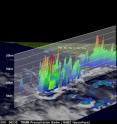NASA sees a hot tower in first tropical depression of the eastern Pacific
The Tropical Rainfall Measuring Mission satellite called TRMM has the ability to see rainfall rates and heights of thunderstorm clouds within a tropical cyclone, and data from the satellite confirmed a "hot tower" near the center of the first tropical depression of the eastern Pacific Hurricane Season. Tropical Depression 1E formed when the low pressure area called System 91E strengthened overnight. Today, June 7, Tropical Depression 1E (TD1E) was located about 365 miles (590 km) south of Acapulco, Mexico near 11.6 North and 100.0 West. It had maximum sustained winds near 30 mph (45 kmh) and was moving to the northwest near 3 mph (6 kmh). Minimum central pressure was near 1006 millibars.
When TRMM passed over TD1E yesterday morning (it was still System 91E at that time) at 0823 UTC (4:23 p.m. EDT) its precipitation radar instrument analyzed the rainfall rates The majority of rainfall occurring at that time was moderate between .78 to 1.57 inches (20-40 mm) per hour, with some isolated areas of heavy rainfall, falling at almost 2 inches (50 mm) per hour.
More importantly, TRMM noticed some of the thunderstorms around the center of circulation were actually what is called "hot towers."
A hot tower is a rain cloud that reaches at least to the top of the troposphere, the lowest layer of the atmosphere. It extends approximately nine miles (14.5 km) high in the tropics. These towers are called "hot" because they rise to such altitude due to the large amount of latent heat. Water vapor releases this latent heat as it condenses into liquid. They're also indicative of a lot of energy within a tropical depression. In the case of Tropical Depression 1E, some of the hot towers reached heights of 16 km (~9.9 miles).
The National Hurricane Center forecasts TD1E to intensify and continue moving in an north-northwesterly direction, steering away from land.
Source: NASA/Goddard Space Flight Center
Articles on the same topic
- NASA catches system 92W become fifth NW Pacific tropical depression13 years ago
- NASA's infrared image of major Hurricane Adrian reveals its stormy life's blood13 years ago
- A double-satellite NASA-style view of the first tropical storm in eastern Pacific: Adrian13 years ago
- Possible first eastern Pacific tropical depression shaping up on NASA imagery13 years ago
Other sources
- NASA sees heavy rainfall in Tropical Storm Sarikafrom Physorg13 years ago
- NASA's infrared image of major Hurricane Adrian reveals its stormy life's bloodfrom Physorg13 years ago
- NASA catches system 92W become fifth NW Pacific tropical depressionfrom Physorg13 years ago
- A double-satellite NASA-style view of the first tropical storm in eastern Pacific: Adrianfrom Physorg13 years ago
- Season's first tropical depression formsfrom UPI13 years ago
- Season's first tropical depression formsfrom UPI13 years ago
- NASA sees a hot tower in first tropical depression of the eastern Pacificfrom Physorg13 years ago
- First Hurricane Of Season Forms In Pacificfrom CBSNews - Science13 years ago
- Satellite spots potential Pacific stormfrom UPI13 years ago
- Satellite spots potential Pacific stormfrom UPI13 years ago
- Possible first eastern Pacific tropical depression shaping up on NASA imageryfrom Physorg13 years ago


